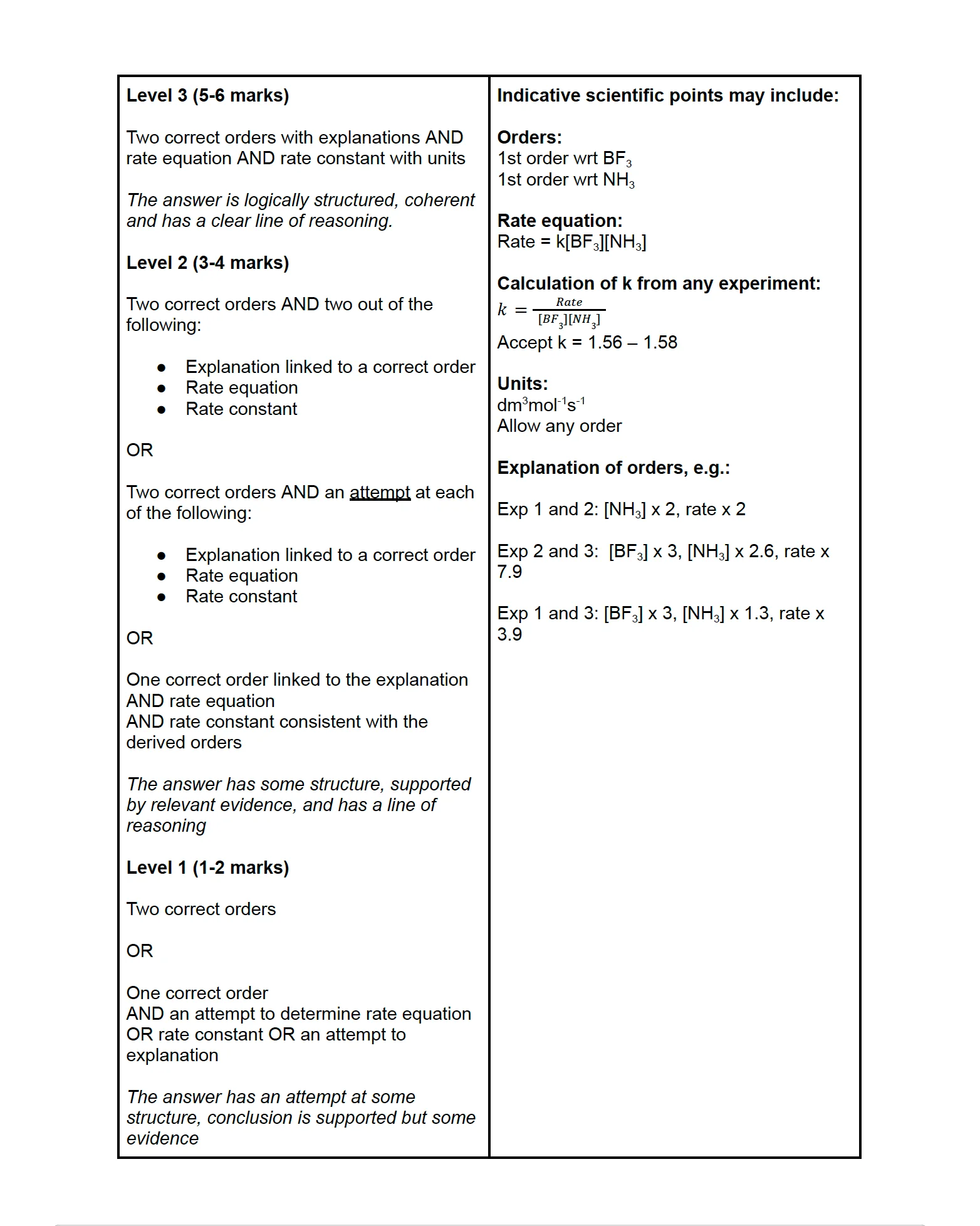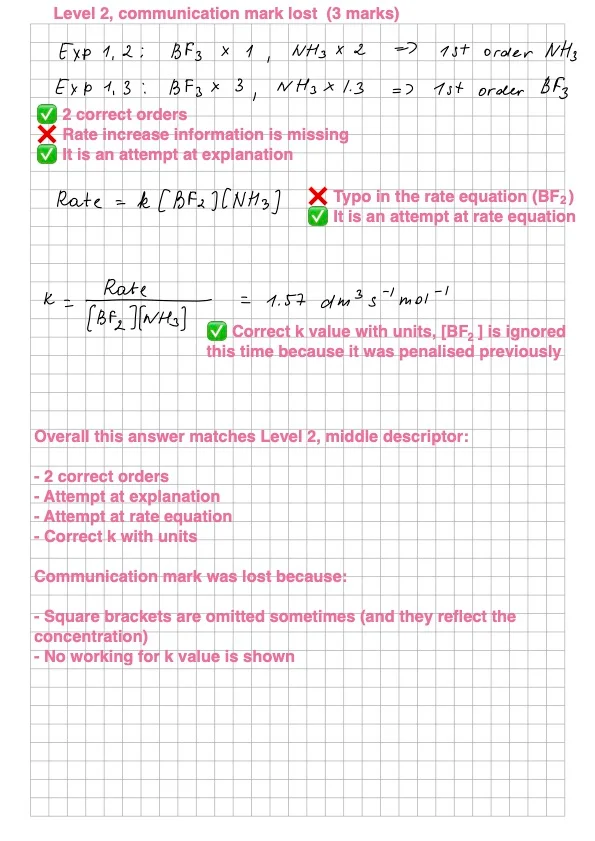GUEST POST
How to Get Full Marks in A-Level Chemistry Levels of Response Questions

Level of Response (LoR) questions are among the most challenging questions in A-level chemistry exam papers.
They can be worth 6 marks or more, depending on the board. These questions not only test your chemistry knowledge, but also your ability to explain concepts and write a coherent answer.
When I say these questions are challenging, I don’t just mean that students struggle to score full marks — I also mean that examiners often struggle to interpret unclear or poorly structured responses.
To keep this post as practical as possible, I will focus on 3-level LoR questions, such as those typical of OCR, though the same general principles can be applied across other boards.
Please note that this is an unofficial guide, not endorsed by any exam board. It is based on my many years of experience as an A-level chemistry examiner, as well as insights from publicly available mark schemes and examiners’ reports.
What’s So Special About LoR Questions?
The most common LoR questions are marked using three levels. You can get:
- 1–2 marks for Level 1
- 3–4 marks for Level 2
- 5–6 marks for Level 3
Each level has a descriptor that includes both a chemistry statement and a communication statement. In addition, mark schemes for these questions will have “indicative scientific/chemistry points”, which show the expected chemistry content in the student’s answer.
The Level is usually assigned based on the chemistry content, but the mark within the Level is determined by how well you communicate your answer.
So, if your chemistry content is good enough for Level 3 but your answer is not well-structured, or you make a small mistake (not big enough to drop a Level), you might get 5 marks instead of 6 – you lose a communication mark within your Level.
How Examiners Mark LoR Questions
First, they read through the entire answer to get a general impression of whether it is weak or strong. At this point, they don’t pay attention to small mistakes or details. They simply check whether all the parts of the question have been addressed and decide whether your chemistry content fits Level 1, 2, or 3, using the indicative scientific points.
Then, they start looking more closely. They double-check that your chemistry content matches the Level they have assigned. For example, if the question involves calculations and your final answer doesn’t match the mark scheme, they will try to find where you went wrong to see if “error carried forward” can be applied to improve the Level. They will also check for any contradictory statements in your response.
Next comes the most challenging part of the marking process — the communication mark. It is awarded if your answer matches the communication statement in the mark scheme, which is often quite vague.
In practice, if your answer matches the Level descriptor, is well-structured, and doesn’t contain irrelevant information, you are awarded the communication mark — meaning you receive the highest mark available for the Level determined in the previous step.
Tips for Answering LoR Questions
- Read the question carefully, and highlight every single point you need to address in your answer.
- Think through the structure of your response – headings, subheadings, bullet points, etc. You don’t have to write an essay, but your structure must be logical. If you use bullet points that don’t follow a clear order, you may lose the communication mark.
- Make sure you address every part of the question, even if you’re unsure how to answer some aspects. Remember, even an attempt to answer the question can elevate your response to a higher level. It’s not uncommon to have “reagents are mostly correct” to be awarded Level 3 — so give these questions a go, even if you’re uncertain!
- Ensure your handwriting is legible. You won’t lose marks for messy handwriting, but your answer must be readable and unambiguous. If an examiner misreads your writing, they may mark it incorrectly.
- Do not contradict your statements. For example, if you write: “Chlorine has weak intermolecular forces, so it has a low boiling point” (correct), but then later write, “Also, chlorine has weak covalent bonds” (incorrect) — this may be treated as a contradiction because it is written in the context of explaining boiling points. In such cases, your correct statement could be cancelled out.
- Do not include irrelevant information. If the question asks about the first ionisation energy trend across Period 3, but you also decide to explain successive ionisation energies (because you are confident in that topic), then in the best-case scenario, you will lose the communication mark. In the worst-case scenario, the examiner might think you don’t understand the difference between the two and treat it as a contradiction.
- Include units. If the question involves calculations, state the units for all values, even if the question doesn’t ask for them explicitly. Omitting units often results in the loss of the communication mark.
- When working with graphs or tables, clearly link your conclusions to the data given in the question. For example, if calculating a gradient, show both points used on the graph. If determining orders from the table, explain which experiments you are using and what the changes in concentration(s) and rate are. Even if your final answer is correct, you could still lose marks if you don’t show your working. In some questions, showing the working is part of the Level descriptor, so failing to do so could cost you both a Level and the communication mark — potentially losing 3 marks in total.
How to Self-mark LoR Questions?
If LoR questions are a nightmare for examiners, rest assured – they are just as difficult to mark as a student. Here is the best approach you can take:
- Focus on the chemistry content of your answer: try to include as many indicative points as possible. If you mention all the relevant points and don’t give any irrelevant information, there’s a strong chance of achieving Level 3 with the communication mark.
- If you cover most of the scientific points but include some irrelevant information that isn’t mentioned in the mark scheme, you may struggle to assess your answer accurately. This is because you'll need to determine whether the irrelevant content contradicts any of your correct statements. In such cases, it’s better to ask your teacher for help.
- If you haven’t mentioned all the points, try to understand the Level descriptors in the mark scheme. Most students can identify their correct Level when they cross-check their chemistry content with the descriptors provided.
- In most cases, it is very difficult to determine whether you’ve earned the communication mark. It’s only one mark, but it’s tricky to assess on your own. Leave that part to your teacher, but do your best to present a logical outline of your answer, use headings/subheadings/bullet points, show your calculations properly, use units.
Below, I will provide a LoR question example, a mark scheme, and 2 examples of marked responses.
LoR Question example [6 marks]
Boron trifluoride can react with ammonia according to the following equation:

A group of students investigates the rate of this reaction by performing three experiments at the same temperature, T. The students’ results are shown in the table below.

Explain how the reaction orders can be determined from these results. Determine the rate equation and rate constant with units for this reaction.
Model Mark Scheme

Model Level 3 Answer

Model Level 2 Answer

Students

Dr. Amna
Tutor
PhD in Biomedical Sciences | A-level examiner | 4500+ online lessons
Looking for a tutor?
Sherpa has hundreds of qualified and experienced UK tutors who are ready to help you achieve your goals. Search through our tutors and arrange a free 20 minute introduction through our industry-leading online classroom.
Find a TutorSimilar Articles



